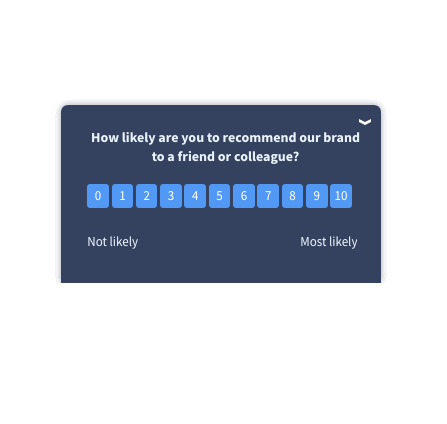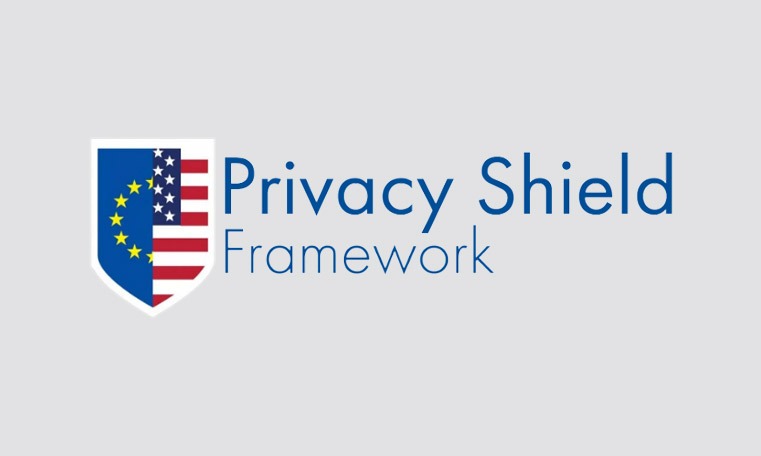As Jeff Bezos puts it, “At Amazon [they] innovate by starting with the customer and working backward. That becomes the touchstone for how we invent.”
You’d think that feedback goes unnoticed when it has over 54 million Amazon Prime members. But applying customer feedback is what has kept the company successful for over 20 years.
To state the obvious, it’s still a market leader and one of the most successful businesses on the planet. And customer loyalty has a significant role to play in this feat.
Building customer loyalty isn’t just about building a better product but also developing a nurturing relationship.
Some of the biggest tech companies have achieved long-term success because of how these brands use feedback and insights.
Customers will pay up to 60% more for your product to have a better experience, implying how indispensable customer feedback is today.
To level up your customer experience game, learn from these 15 customer experience feedback examples of brands. Here’s how they act on customer feedback to create a superior experience and gain customers for a lifetime.
But before we begin, let’s quickly understand what customer feedback is.
Why Does Customer Feedback Matter at All?
How about we take a personalized approach rather than just listing out stuff you can find on Google? Let’s discuss some examples of how brands use customer feedback.
These companies used customer feedback to enrich their sales funnel with leads and also enhance their customer experience.
These are the case studies of Qualaroo clients that’ll help unravel the benefits brands enjoy from customer insights.
Boost Conversions
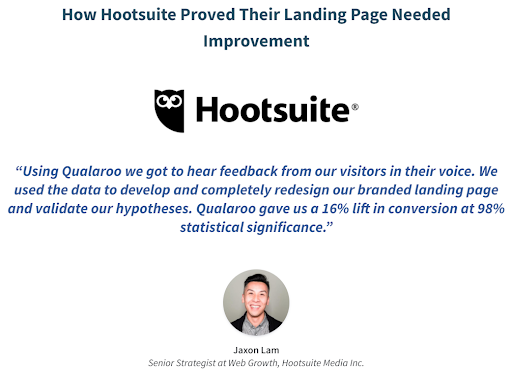
HootSuite is a social media management platform enabling its users to manage all their social media accounts in one place.
HootSuite was initially under the impression that its website visitors knew what kinds of services they offer. So, they packed their landing pages with rich media focused on highlighting high-level functions.
The growth team at HootSuite analyzed the home page and the CTR on the pricing page. It hypothesized that the SEM traffic required more detailed information about the platform.
At this point, they needed a customer feedback tool like Qualaroo that would help them deploy on-site surveys to test the hypothesis by asking customers directly about what was missing on the website.
Soon they found that around 65% of the website visitors said they required more information before making any decision.
Taking customer feedback by the word, HootSuite revamped its landing pages to explain its core services using a language customers can resonate with.
Soon after they A/B tested the original and new pages, their results showed a 16% lift in conversion at a 98% statistical significance.
Takeaway: By asking a simple question like “Do you think there is enough information on the page to make a decision?” HootSuite was able to improve its conversions by a significant margin.
Find the Most Effective Marketing Channels
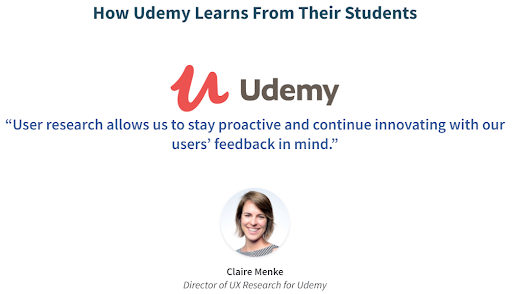
Udemy is an online learning platform that provides streamable online courses. Being a global platform, Udemy utilizes several marketing channels.
The dynamic customer demographic for Udemy demands different marketing strategies tailored to each location to get the best results.
Udemy turned to customer insights to explore the most popular marketing channels for different countries to reallocate funds and strategize accordingly. It is why the company used surveys.
A simple survey question like “How did you come to find out about Udemy?” allowed them to identify advertising channels that were working for them.
Another way Udemy optimized customer feedback is to explore the performance of its machine learning-based auto-captioning.
Using metrics such as customer satisfaction or rating surveys allowed them to understand if they needed to improve auto-captioning.
Udemy used branching logic to collect contextual feedback and added a follow-up question whenever a user gave a low rating.
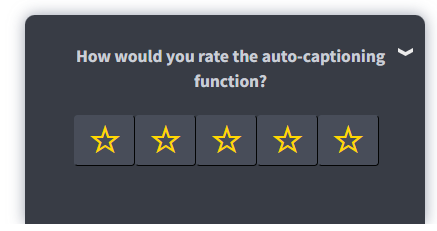
In the words of Claire Menke –
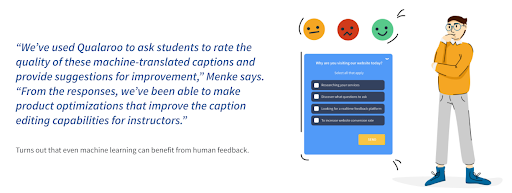
[Related read: What Is Customer Feedback Software and How to Choose the Best One]
Discover New User Personas and Track NPS Metric
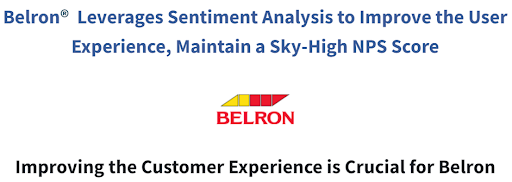
Belron offers windshield services online in different countries. Many of its customers are only one-time users who have a broken windshield and need it replaced.
Belron’s use of customer feedback is three-fold –
Learning from shoppers who never become customers.
By deploying an exit-intent survey on its website, Belron gathered insights from leaving customers who didn’t make any purchases.
It was crucial to do so since Belron’s customers don’t want convincing via marketing but have a genuine need for windshields.
So, it didn’t make sense to them why customers were leaving. Belron explored different user personas they never knew existed with the exit-intent survey.
With this discovery, they optimized their marketing strategies to target the new user persona and create a suitable customer journey.
Tracking NPS metrics to keep tabs on customer experience and satisfaction.
Belron’s users are frustrated customers who want to replace their broken windshields. So, the brand needs to offer a seamless and straightforward experience.
For this, the company used NPS surveys to track their NPS score. Along with this, the company started asking open-ended follow-up questions with users who rated low NPS to collect their open-ended responses.

[Related read: Customer Satisfaction Metrics To Monitor in 2022]
Collecting and analyzing customers’ open-ended responses for qualitative insights.
Now, simply collecting data from an open-ended survey isn’t going to do the trick. You need to analyze the free-range responses to understand the customer sentiment and why it is so.
For this, Qualaroo’s IBM-powered Sentiment Analysis came in handy as they were able to quickly view the themes and patterns from customer responses.

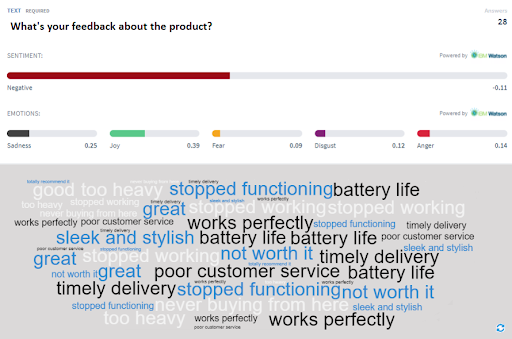
Increase Email Subscribers’ List
The University of Alberta had 50,000 monthly unique page views but only saw 1-2 email signups and had only 500 subscribers despite the traffic.
It implemented Qualaroo NudgeTM pop-up surveys to increase its subscribers’ list. The pop-up was targeted to appear if the visitors stayed on the page for 10 seconds.
The university would ask visitors if they were interested in UoA news, and if they said yes, they would be asked to mention their email addresses.

Almost immediately, the subscribers’ count per day increased from 1 to 2 signups to 10.
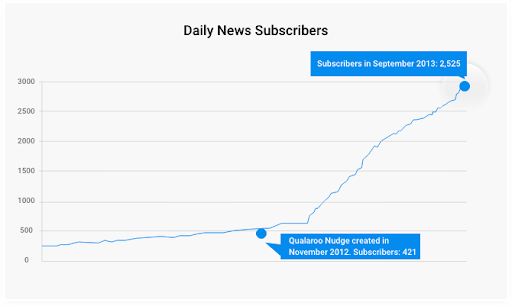
The subscribers’ list exponentially grew by 500% in a year. The signup rate rose to 20% and continues to do so.
Now, let’s move on to more examples from brands and how they utilize customer insights to improve their processes, customer experience, and sales.
Top 15 Companies That Use Customer Feedback the Right Way
Let’s look at each customer experience feedback example by these famous brands and explore what strategies worked for them.
Apple Uses NPS Surveys to Generate Over $25 Million Additional Revenue
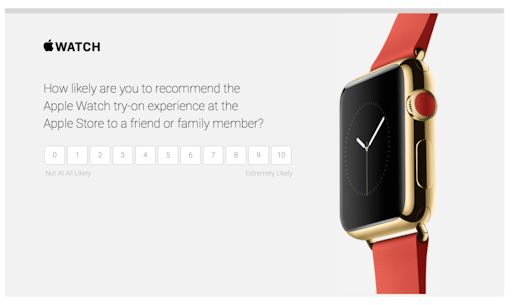
Of course, it doesn’t come as a surprise to you that Apple is at the top of the list. Apple spends close to $1 billion per year on its retail stores even though they have an online presence.
The company has consistently achieved the highest sales per square foot of any US retailer because of its relentless focus on the store experience.
Ron Johnson, an executive behind the Apple store design, said: “[The stores] would be designed to encourage an ongoing relationship with customers, not merely a one-off purchase transaction. The delighted customers […] would tell their friends and colleagues about their wonderful experience at the store.”
Apple collects insights through retail customer feedback NPS surveys to find detractors and improve its retail store experience. Whether customers made a purchase or scheduled an appointment to try on an Apple Watch, they email a survey to rate the in-store experience.
Apple carefully analyzes NPS survey comments daily and follows up with customers who score 6 or lower. In many retail stores, customer comments from NPS surveys appear on a large TV in the break room.
Apple also conducts daily meetings with the respective team to review the NPS feedback and address detractor comments.
The store managers also call detractors within 24 hours to determine what problems they face and what needs improvement. Managers share feedback from these calls to teach their employees how to improve customer interaction.
When they began this practice, Apple found that detractors they contacted became bigger buyers than promoters. This simple follow-up generated over $25 million in additional revenue in a year.
Southwest Airlines Used Social Media to Address Customer Travel Concerns
Southwest Airlines manages up to 3,900 flights per day. They also monitor the needs of over 100 million yearly customers.

Southwest used social media to respond quickly and manage their customers’ travel concerns. They had a specially-designed social media “Listening Center” with 31 team members that monitored and responded to thousands of tweets per day.
But, how did the customer feedback help them improve customer service?
They carefully analyzed tweets and other social media posts mentioning Southwest Airlines to see if a customer needed help.
The feedback allowed the team members to offer real-time customer service, such as tracking lost luggage or rebooking a missed connection. Southwest was able to respond to customers on Twitter faster than any other airline with this system.
Zappos Used Phone Support to Provide Personalized Service
75% of Zappos’ repeat business comes from returning customers who make large purchases at least twice a year. 43% of new customers come from word of mouth. Additionally, Zappos’ success relied heavily on using their 24/7 support channel.
Zappos used phone support to make personal connections with each customer. On average, a Zappos customer service agent answers up to 5,000 calls a month.
Zappos gave freedom to its representatives to do what they saw suitable for the customers without a supervisor’s approval. But they only allowed it when the representatives had a four-week training process in company culture and customer service ideals.
It allowed representatives to creatively go out of their way to make their customers happy. For example, when a nearby customer called about shoes being out of stock, the representative purchased them from another store and hand-delivered them for free.
The recurring revenue from loyal customers outweighed the cost of personalized customer service. Zappos invested in the customer experience and used it as their prime marketing point.
Salesforce Collaborated with Customers to Innovate
Salesforce has created the IdeaExchange to manage customer suggestions for new features. After submitting ideas, customers could search them and vote on which features they wanted the company to include.
When each idea had 250 votes or 2,500 points, they were reviewed by the Product Development Team.
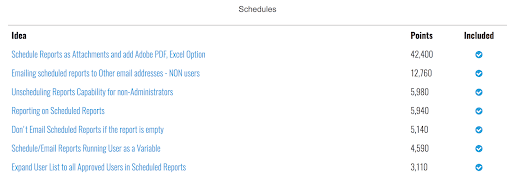

Besides collecting feedback and deciding which features to include, Salesforce made its customers feel valued by individually thanking them for ideas that they selected.
By involving their customers in product development, Salesforce introduced features that served their customers’ specific needs.
Watch: How to Collect Customer Feedback
Trader Joe’s Listens to Shopper Preferences to Customize Inventory
Trader Joe’s made $1750 in sales per square foot by customizing each store’s inventory using customer feedback. But their feedback didn’t come from focus groups, email, or call centers.
The store captains and crew members conversed with the customers and offered them product samples. They learned first hand which products their shoppers wanted.
For example, once one customer tried a soy ice cream cookie at a Trader Joe’s location in Southern California and requested the same product at her local Nevada store. After a while, they started carrying it in multiple stores.
As Audrey Dumper, VP of marketing for Trader Joe’s, says, “We like to think of Trader Joe’s as an economic food democracy.” They used feedback to remove products that didn’t sell well and made room for more heavily demanded products.
By customizing inventory and the order management process, they created a unique experience tailored to local shoppers.
UBER Listens to Both Users and Employees to Improve Overall Experience
Reasons for Uber’s success are not hard to guess. This on-demand ride-hailing service has emerged as a trendsetter in the industry, applauded for its customer experience.
One of its secrets for excellent customer service is listening to the customers.
The company follows the philosophy of “Feedback is a Two-Way Street,” expressing how crucial feedback is for companies. Uber has a feedback loop that benefits both riders (users) and drivers (employees).
According to Uber, “Real-time feedback about drivers means Uber can correct for issues, big and small – while ensuring that only the best drivers stay on the road. We take this feedback seriously – depending on the circumstances, rider feedback may lead to deactivating a partner from the system or serve as validation that the driver is providing great service.”
Since the company offers an on-demand ride-hailing service, its growth and strategies rely heavily on customer feedback. The insights from users and drivers ensure that Uber offers a better experience for both.
Now, the question is – How does Uber do it?
Well, once a ride is complete, an in-app survey appears on the screen for both parties involved. Customers can rate the driver and their experience, and drivers can rate their customers.
The reason why companies use surveys like these is that they are non-intrusive and effective.
[Bonus read: 11 Best Mobile In-App Feedback Tools]
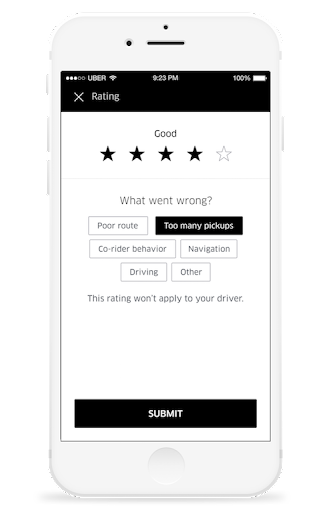
Feedback has become equally indispensable for the company and its drivers. It’s because drivers’ ability to earn with Uber depends on their rating. They have to maintain a specific rating to continue to work with Uber.
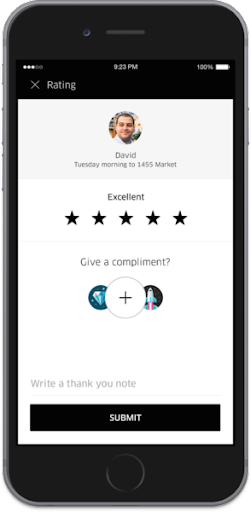
However, Uber did face a few hiccups on the way, but it listened to customer feedback and overcame them.
For example, Maxie Schmidt, VP, Principal Analyst, explained in the article how her acquaintance had a bad experience with a driver and wanted to share the feedback.
However, they felt the survey options were limited and didn’t express her experience.
Even when they chose “Other” as an option, the survey just ended without giving them a chance to share contextual feedback. It is a classic survey error that occurs while asking for customer feedback.
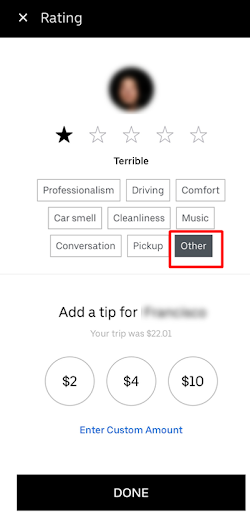
Uber listened to what customers had to say and came up with an elaborate solution.

It added a section that allowed customers to share their feedback and experience from the app about the driver and the ride.
Hyatt Scored More Than the Industry Average of 75 in Customer Satisfaction
Hyatt has made such a big name in the hospitality industry. Much of its popularity is owed to its willingness to listen to the voice of customers.
The hotel chain focuses on collecting customer feedback through different channels and enhancing the experience in every possible way. Those channels are ─ Website surveys and Social media.
- Website surveys
Hyatt has a dedicated landing page where customers can share their experiences about their recent stay with Hyatt. It is an excellent opportunity to let customers engage with the company and provide feedback on what they need to improve.
One of the easiest ways you can use customer feedback to your advantage is by adding Google reviews to your website. This helps establish trust, boost sales, reduce bounce rate, improve your rankings, and improve your brand’s reputation.
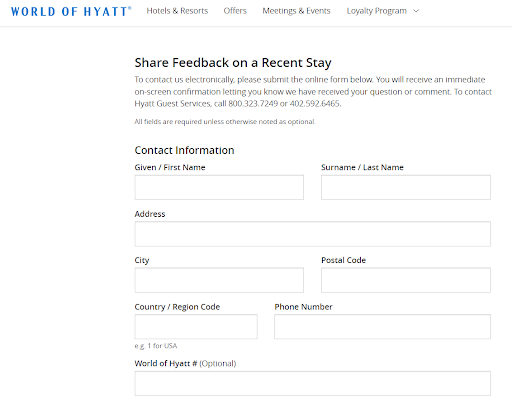
The hotel chain also offers incentives to customers to take the survey, which is one of the creative ways to get customer feedback. Now that’s a page right off the book of using psychology to get customers to take your surveys.

- Social media ─ Instagram and Twitter
Social media is undoubtedly the blood and bones of companies, and not just for marketing. Many customers share their honest feedback and experiences with a company on social media, such as in the comment sections of posts, tagging in tweets, etc.
Hyatt tracks what customers talk about on their social media accounts on Instagram and Twitter to understand where their services are lacking.
The hotel chain also encourages customers to use #WorldOfHyatt and #WorldOfunderstanding hashtags to share their stay experiences with different Hyatt properties worldwide.
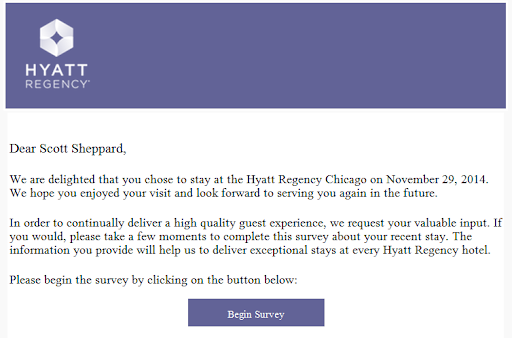
Hyatt also sends follow-up surveys to its customers to listen to their experiences and suggestions for the hotel chain.
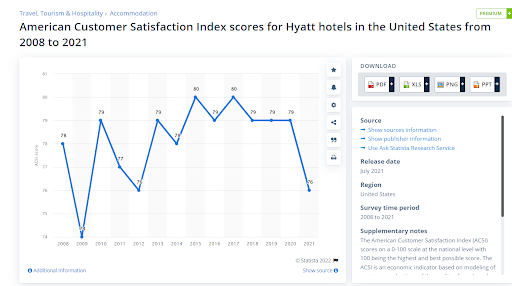
By investing such effort and resources into customer feedback, it sure got fat returns on the investments ─ Hyatt surpassed the industry average of 75 in Customer Satisfaction even during the pandemic.
Timberland Listened to Its Customers and Implemented Avenues for Feedback and Reviews
In the words of former Brand President at Timberland, Stewart Whitney, “When you go after lots of consumers, with lots of messages, the odds are higher for a misfire…The fact that we didn’t stand for anything distinctly meant we didn’t really resonate.”
Since its inception, the brand was unaware of the fact that only knowing their customers are shoe lovers is not enough.
Unfortunately, after years of ineffective marketing and unclear customer journey maps, Timberland realized there is more to customer behavior and needs than just customers’ love for shoes.
Timberland did not know what it stood for, so it couldn’t resonate with the customers. After finally realizing the need for customer feedback, the brand prioritized and joined hands with VF Corp to collect feedback from 18,000 customers from 8 countries.
Upon acting on customer insights, Timberland added a review section on each product page where customers could rate the product, share their experience, and images and videos of their products.
It helped Timberland to keep track of each product’s performance by analyzing the reviews and ratings.

The brand also launched a live chat option on each product page to resolve customer queries and collect customer insights.

Pro Tip: Having a customer relationship management tool like BigContacts can help you automate and streamline customer interactions to capture more leads, convert more opportunities, and retain more customers.
Starbucks Enjoyed a Staggering NPS of 77
Did you know that Starbucks, a chain of coffeehouses, had a staggering Net Promoter Score of 77 in 2016?
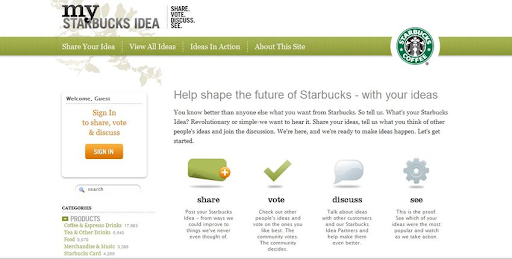
But, how did it do so?
It’s simple ─ if customers feel heard, it instantly boosts their satisfaction level. In 2008, Starbucks introduced a customer feedback-centric campaign, “My Starbucks Idea.”
The website aimed to boost customer engagement and provided a platform for customers to share what they wanted with the company. They got 70,000 responses, which grew to 190,000 by 2015.
By 2013, Starbucks implemented 275 customer ideas focused on product improvements, service improvements, and corporate responsibility ideas.
As of February 2022, the NPS for Starbucks stands at 39, which is considered a respectable score.
SiteGround Leverages Three Channels to Collect Customer Feedback
You know a company isn’t complacent towards feedback when it leverages three different channels to collect customer insights.
SiteGround uses live chat, phone support, and help desk tickets as platforms to allow customers to share their experiences and suggestions with the web hosting company.
You can also go for laravel hosting services to experience superfast hosting.
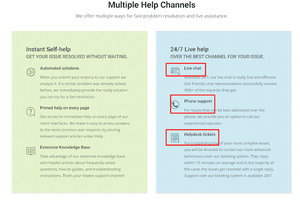
SiteGround is known for tracking customer experience using customer support interactions. When customers complete their interaction with a support representative, they are asked to rate their experience.
After the rating, they are asked an open-ended question to explain their experience and feedback.
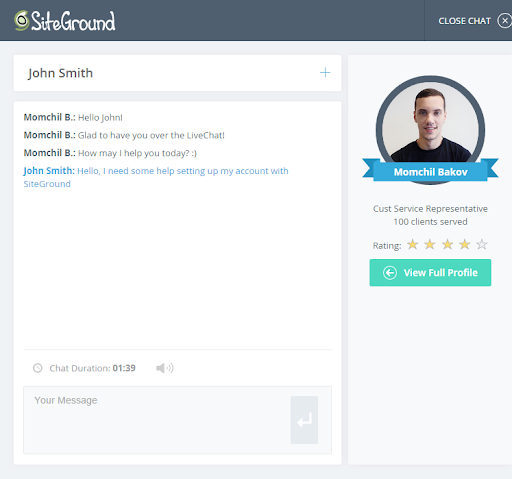
SiteGround takes feedback one step further. Right after customers share their reviews, they are posted on Yelp so other customers can see them.
Pro Tip: If you wish to add surveys to your online chat software, you can integrate a survey tool like Qualaroo with ProProfs Live Chat in just a few steps and enjoy the best of both worlds.

Tesla Implements Several Customer Feedbacks in a Week
Tesla is an automobile company run by CEO ELON MUSK.
Do we need to say more?
We are already sure you know Elon Musk and his way of personal marketing and relationship-building. But more than marketing, his strategy leans towards customer engagement and feedback.
Connecting directly with the customers allows Tesla to shorten the feedback loop, making implementation instant.
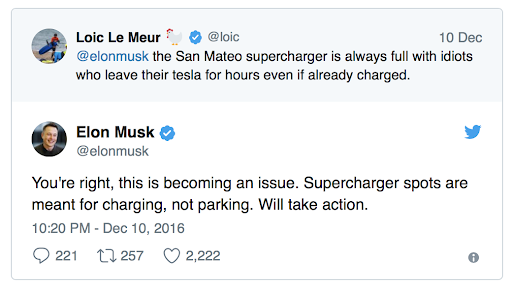
Not just the CEO, but the whole organization runs on customer feedback. Each week, the company makes 20 engineering changes and updates its Model S vehicle. And the majority of these updates are in response to customer experience and their feedback.
The direct interaction with the company founder and instant feedback implementation is a genius way to improve customer loyalty.
YouTube Conducts Surveys to Improve Recommendations
If you are someone like us who loves to binge YouTube videos, you must have come across YouTube surveys at least once.
A survey randomly pop-ups on your screen asking your opinion on a video you have watched before.
It asks you how accurate the recommendation is for your taste and what qualities it has ─ Is it educational, entertaining, informative, helpful, novel, or relaxing? You are also asked to rate the video.

Doing so allows YouTube to improve its algorithm for more personalized video recommendations. Not just for this, YouTube also conducts surveys for its advertisements.
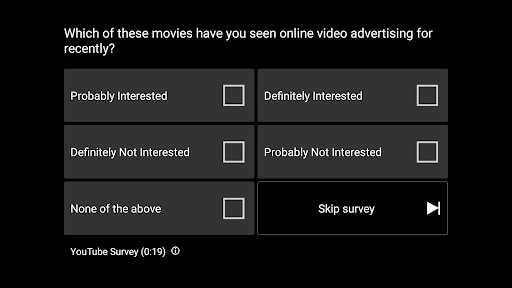
Netflix Sends Email Surveys to Improve Personalization
Video streaming service Netflix is known for its personalized experience. The question is, “Where does the data for personalizing experience come from?”
Netflix is obsessed with customer feedback and uses these insights to improve personalized recommendations for each user.
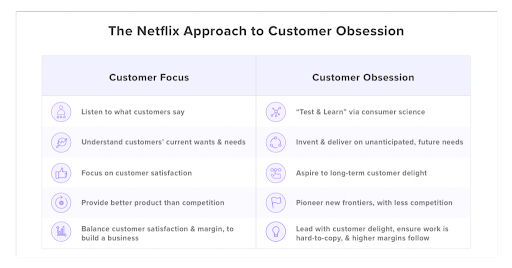
One way Netflix collects feedback is by the row system. It creates rows of different content recommendations, and if customers scroll down the row, it indicates they are not interested in it.
Another example of customer feedback collection is online surveys. Netflix sends email surveys to users to ask about their experience.
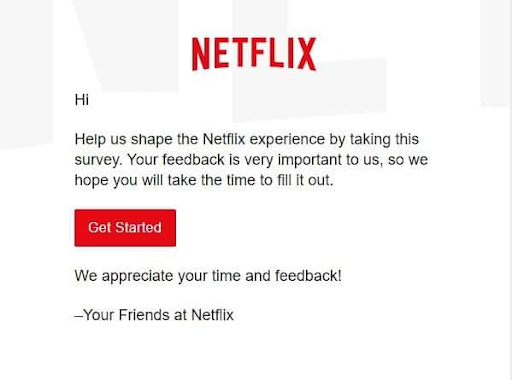
It also asks users directly about their preferences rather than just using algorithms to track user behavior and preferences.
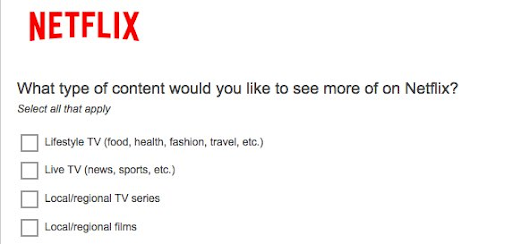
Netflix also collects feedback on its content. Earlier, Netflix used to ask users to give star ratings to its content, but it confused users as star ratings are used to measure product satisfaction and not ‘personal experience.’
Once Netflix realized this, it switched to thumbs up and down rating, which is easier and clearer to understand.

Airbnb Asks Customers About Their Stay Experience and Feedback
Airbnb is an online marketplace for temporary lodgings and rentals. The company provides different means to customers to reach out to the company for help or share feedback.
Airbnb uses email surveys to ask its customers about their experience on their recent stay with one of its properties. Surveys are conducted once customers complete their journey, making the surveys less invasive, brief, and easy to take.
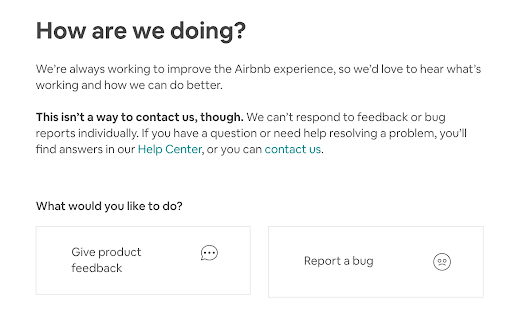
Customers are more comfortable sharing their experience this way instead of offline survey cards. It allows customers time to respond and the company to collect NPS and track customer satisfaction.
HubSpot Tracks NPS and CSAT Metrics Using Surveys
HubSpot is a popular Customer Relationship Management software (CRM) that offers a suite of different features. HubSpot implements advanced NPS surveys to track its overall NPS.
Customer satisfaction surveys for companies also have a lot to offer, which is why HubSpot tracks the CSAT metric.
The survey comprises multiple open-ended questions and ratings to allow customers to be expressive while sharing their invaluable feedback.
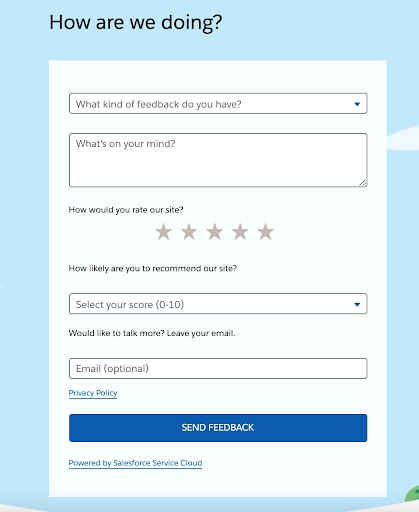
Use Feedback to Increase the Customer Lifetime Value
Listening to your customers reveals specific areas where you can improve their experience. But following up on their feedback can help you build more than a positive experience.
As Jeff Bezos said, “If you do something good for one customer, they’ll tell 100 customers.”
When you use feedback to build deeper connections with your customers, you’ll retain more loyal promoters who are excited to share their experiences. They’ll become your best marketers as you continue to grow.
To sum up, you can take a leaf out of the books of these brands to implement the following strategies for success:
- Use NPS and CSAT surveys to generate revenue
- Use social media to address customer concerns
- Use phone support to provide personalized service
- Collaborate with customers to innovate
- Listen to shopper preferences to customize inventory
- Listen to both users and employees to improve overall experience
- Leverage multiple channels to collect customer feedback
- Conduct surveys to improve product recommendations
- Send email surveys to improve personalization
Channel Your Curiosity Towards Customers’ Experience to Collect Feedback
You see, all these top brands that collect customer feedback and are at the top of their game have one thing in common — Their curiosity towards customer experience.
It’s never too late to channel your curiosity in the right direction and start collecting customer feedback.
You need to start somewhere. It could be anything from re-evaluating and segregating your target audience to choosing a customer experience and feedback tool.
Just make sure whatever insights you get from your efforts, you implement them and move towards a proactive approach
FREE. All Features. FOREVER!
Try our Forever FREE account with all premium features!


 We'd love your feedback!
We'd love your feedback! Thanks for your feedback!
Thanks for your feedback!


